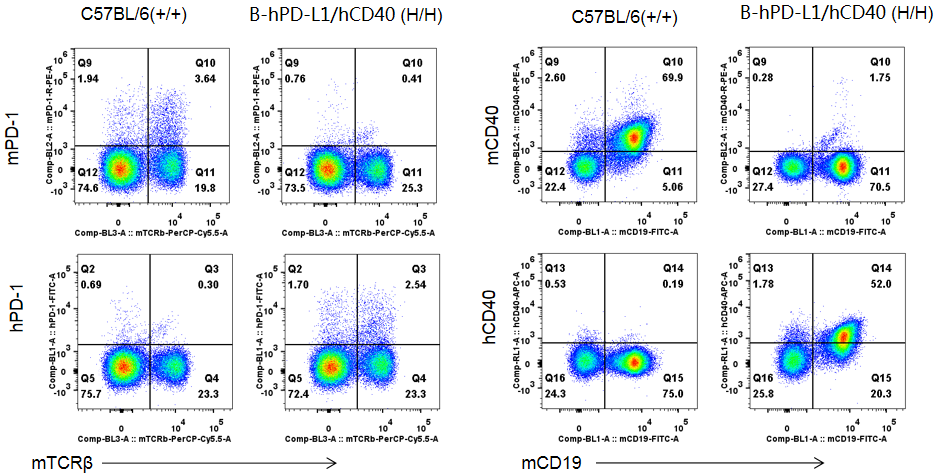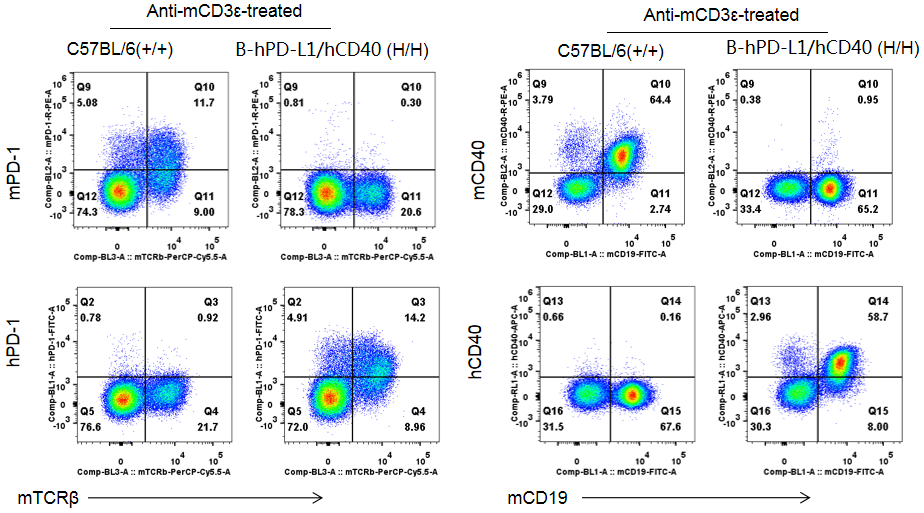Protein expression analysis

Strain specific CD40 and PD-1 expression analysis in homozygous B-hPD-1/hCD40 mice by flow cytometry. Splenocytes were collected from WT and homozygous B-hPD-1/hCD40 (H/H) mice analyzed by flow cytometry with species-specific anti-PD-1 antibody and anti-CD40 antibody. Mouse CD40 and PD-1 were detected in WT. Human CD40 and PD-1 were exclusively detected in H/H B-hPD-1/hCD40 but not WT mice.

Combination therapy of PD-1 mAb (keytruda) and CD40 mAb

Antitumor activity of anti-hCD40 antibody Selicrelumab (in house) combined with anti-hPD-1 antibody keytruda in B-hPD-1/hCD40 mice. (A) Anti-hCD40 antibody Selicrelumab (in house) combined with anti-hPD-1 antibodies keytruda inhibited MC38-hPD-L1 tumor growth in B-hPD-1/hCD40 mice. Murine colon cancer MC38-hPD-L1 cells (5×105) were subcutaneously implanted into homozygous B-hPD-1/hCD40 mice (female, 6 week-old, n=8). Mice were grouped when tumor volume reached approximately 100-150 mm3, at which time they were treated with antibody Selicrelumab (in house) combined with anti-hPD-1 antibody keytruda with doses and schedules indicated in panel (B) Body weight changes during treatment. As shown in panel A, combination of anti-hCD40 and anti-hPD-1 antibody shows more inhibitory effects than individual groups, demonstrating that the B-hPD-1/hCD40 mice provide a powerful preclinical model for in vivo evaluating combination therapy efficacy of hCD40 antibodies and hPD-1 antibodies . Values are expressed as mean ± SEM.
Combination therapy of PD-1 mAb (keytruda) and CD40 mAb

Antitumor activity of anti-hCD40 antibody Selicrelumab (in house) combined with anti-hPD-1 antibody keytruda in B-hPD-1/hCD40 mice. (A) Anti-hCD40 antibody Selicrelumab (in house) combined with anti-hPD-1 antibodies keytruda inhibited MC38 tumor growth in B-hPD-1/hCD40 mice. Murine colon cancer MC38 cells (5×105) were subcutaneously implanted into homozygous B-hPD-1/hCD40 mice (female, 4 week-old, n=8). Mice were grouped when tumor volume reached approximately 100-150 mm3, at which time they were treated with antibody Selicrelumab (in house) combined with anti-hPD-1 antibody keytruda with doses and schedules indicated in panel (B) Body weight changes during treatment. As shown in panel A, combination of anti-hCD40 and anti-hPD-1 antibody shows more inhibitory effects than individual groups, demonstrating that the B-hPD-1/hCD40 mice provide a powerful preclinical model for in vivo evaluating combination therapy efficacy of hCD40 antibodies and hPD-1 antibodies . Values are expressed as mean ± SEM.
Combination therapy of PD-1 mAb (keytruda) and CD40 mAb

 苏公网安备:32068402320845号
网站建设:北京分形科技
苏公网安备:32068402320845号
网站建设:北京分形科技






 010-56967680
010-56967680 info@bbctg.com.cn
info@bbctg.com.cn